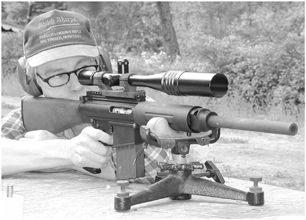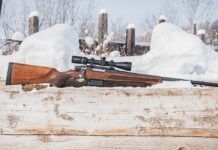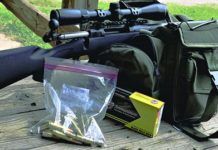
In response to many requests to test .308 versions of the AR-15, we acquired three of the more prominent examples. These were the Bushmaster .308 20 IZ, $1780; ArmaLite AR-10A4, $1506; and DPMS Panther’s Long Range 308B, $1319, which price includes $170 for a factory trigger job.
All three rifles had matte-black finishes on their metalwork and fittings, with exceptions as noted. In all three cases the finish was evenly applied, and all three guns looked pretty good on the surface. There were a few differences in stock design (Bushmaster) and in the forends (DPMS), but the similarities were overwhelming. All came with at least one 20-round mag. The ArmaLite came with a 10-rounder too, and the DPMS came with two 20-rounders. Bushmaster provided only one magazine, but the rifle accepted both metric and British FAL magazines. Metric FAL magazines are plentiful and inexpensive, which made us wonder why we got only one with the rifle. All had pistol grips. Two had flash hiders, the DPMS being the odd man out. All three had Picatinny rails, which made mounting our 36X Weaver test scope a breeze. The safety levers were all identical and non-ambidextrous. Oddly, none of the magazines interchanged. Contrast that with just about any maker’s .223, where any AR-15-type magazine will fit. Not so with the non-mil-standard .308s.
Getting ahead of ourselves, the idea of semiautomatic rifles being tack drivers is not commonly accepted, but we found ourselves taping up group after group with mighty small pieces of tape, generally one piece per three-shot group. Something very odd was happening with these rifles, we thought. Let’s see how well each one worked.
[PDFCAP(1)]
This rifle had an unusual skeleton stock configuration, the main tube of which was wrapped with soft, rubber-like fabric that we found to be most comfortable. The rifle worked well with all FAL magazines we tried, and in fact our FAL magazines fit the magazine well better than the supplied magazine, and thus rattled less. We liked the downward bolt-trip lever much more than the common AR-15 or AR-10 type. The Bushmaster’s magazine release was completely ambidextrous. A push on either the right or left button would drop the mag, which we found handy, but we thought the needed push was too heavy. The bolt trip was also ambi, with an extension on each side. The stock had a recoil pad, the only one of the rifles so fitted, and we liked it. Early in our testing the rear sling swivel fell out, being only partially screwed into its recess. Once tightened, it stayed put.
Just in front of the forend were three short rails (formed on the gas block), one on top and one on each side of the barrel, to mount various objects. The rifle came in a hard case along with one 20-round magazine, a sling, a manual, a catalog, and a zeroing target. There was no way to attach the sling to the forend, despite the “trick” three-rail gas block. Inspection of the catalog revealed that a sling stud, $5, could be screwed into the gas block. Then you’ll have to have the QD swivels, for an additional $12. In defense of Bushmaster, there are many ways to attach a sling to this rifle, and each buyer may want to customize the sling attachment for himself, but we felt the rifle was incomplete without some means of sling attachment at the front.
The ventilated forend was long and generally mil-spec in its look. The cocking handle had an odd detent that we liked, unlike the common latching lever found on all AR-15s. The receiver, alone of the trio, had a forward-assist knob. It also had a block to keep empties out of the face of lefties, and a hinged port cover, the latter two features common also to the ArmaLite. Workmanship on all three rifles was about the same, generally excellent, with the exception of the trigger quality.
[PDFCAP(2)], the first thing we discovered while sighting in the rifle was that its trigger was horrendous. There was massive creep at about 7 pounds, a hitch, and then at 9.3 pounds came the final break. This on a rifle costing the better part of two grand. We noted the manufacturer will be glad to sell you one of two trigger kits for this rifle for an additional $120 or $140, and they say they are “for the serious High-Power competitor.” We believe they should say the extra-cost triggers are for all serious riflemen who actually want to hit something with the rifle from field positions. Without a good trigger the most accurate rifle will very likely be a total loss when you most need it. In our opinion the rifle — any rifle — is incomplete without a really good trigger, and there is no justification for the need to spend an additional $120 to get what amounts to one of the most necessary parts of the rifle. All three of the rifles in this test failed in this respect, because each and all charged more — lots more — for what we believe ought to be standard.Having said that, we found that the Bushmaster was thoroughly deserving of a good trigger pull, because it appeared to be a decently accurate rifle. Whether you buy this rifle for match competition or for self defense or for fun, you probably won’t be shooting it from a machine rest all that often. But it took all we had, using the machine rest, to get the groups we fired because of the poor trigger. From field positions the rifle’s inherent accuracy was unattainable.
This was otherwise a good rifle. It never failed to feed, fire, or eject. Accuracy was, as far as we could tell, excellent. We tested the three rifles with Chinese surplus, and with both Federal and Winchester match ammunition. The Bushmaster took them all in stride, making the smallest groups with one or the other brand of match ammo. We could see little difference between the two types here. One thing we found with all three rifles was that shooting from the bench was uncomfortable because our ear protectors got in the way of the stocks. This was less of a problem in field positions, but these straight mil-type stocks are not the best for a riflemen’s shooting comfort, we have found. Recoil was not noticeable on the shoulder from any of the rifles.
[PDFCAP(3)]
We liked the looks and the balance of the AR-10 at first glance. The flat-top rifle came with a clamp-on handle with rear sight, and a suitable front-sight assembly. There were two magazines as well, and a sling that could actually be attached to the rifle. The slim 20-inch barrel had a brake/flash hider that added to the looks of the rifle, we thought. The overall color of everything was a uniform matte black, and workmanship was excellent. This was a fairly straightforward .308 semiauto, with mighty few frills.
We attached our scope and, during sighting in, encountered an even more evil trigger than the Bushmaster had. The ArmaLite’s had bad creep at 7 pounds, more at 8 pounds, and final break came at 11 pounds. Do these manufacturers believe the shooter is going to pick up the rifle by the unlocked trigger, and want to make sure the rifle won’t fire under those conditions? Both the Bushmaster and ArmaLite could be suspended with all the rifle’s weight on the cocked trigger, and the hammers would not fall until the rifle was bounced on the trigger finger. The ArmaLite took a good deal of bouncing.
The AR-10 came with a thoroughly outstanding operator’s manual that was large and legible, and had pictures that one could actually decipher. We laughed at two insertions in the manual. One admitted the “normal” trigger pull was long, heavy, irregular, and distracting to accuracy. The second was from an insert in the manual relating to breaking in a match barrel, in which it was noted that every accuracy problem is from failure to break the bore in properly, or from poor ammo, or from poor marksmanship.
No maker can help your marksmanship, but with such an admittedly lousy trigger, we don’t see how ArmaLite can sell the rifle as a complete product. Five pounds we can see, but eleven? Lest you think we complain too loudly or that semiauto .308s require heavy triggers, we have on hand a .308 and a .30-06, both with two-stage triggers. The first stage takes all of three pounds, and the final break comes at four pounds with zero creep. The triggers on the ArmaLite and Bushmaster are sinful and incomplete.
On the range we again had tiny groups with great effort to get past the lousy trigger, but we can’t help feeling the groups would have been smaller if we had been able to fire the rifle more easily. We managed one sub-one-inch group with Federal match, but couldn’t repeat it. The Chinese ammo shot sub-2-inchers with regularity. There were no failures to fire or eject, but we noted the rifle kicked our face from stock upchuck more so than the others, most likely because of the slim barrel and reduced weight. We also noted the magazine took some getting used to. You had to press a button on its back to load the second round, but then they were easy. There were no ambidextrous features to the rifle at all, other than the case-deflecting bump behind the ejection port.
[PDFCAP(4)]
This heavy rifle had an 18-inch bull barrel. The action was clearly not a stock AR-15 or AR-10 type. It did not have the empty-cartridge deflector, nor did it seem to need it. It didn’t have a forward assist button or a port cover either. Yet takedown was identical to the other two rifles, common to AR-15s. Inside, the relatively massive dimensions of the action parts were obvious. This rifle seemed to be designed for stability and accuracy. The price included $170 for a trigger job. Without it (buyer beware!) the rifle cost $1149, vast savings over the other two.
The company offers a variety of rifles in numerous calibers, including at least three variants in .308, with shorter and longer barrels. The company also offers a vast variety of pre- and post-ban barrel assemblies for AR-type rifles in a great variety of lengths and weights, including some in .22 LR and 7.62×39.
The aluminum forend of our test rifle was short, and of the “floated” type. It had a sling swivel stud on its bottom. The upper action of this blocky rifle was of thick, extruded 6066-T6 aluminum, which was mil-spec hard anodized and then coated with black Teflon. The lower was of 6061-T6 aluminum, milled from a solid blank, and also black Tefloned. The stock was mil-spec with trapdoor butt and black finish. The forend and barrel and magazine were not Teflon finished. The heavy barrel did not have a flash hider, but had a deep, recessed crown. One thing we all noticed is that nothing felt loose and nothing rattled on this rifle. It was blocky, felt solid, and had even fewer frills than the ArmaLite.
On the range we immediately appreciated its better trigger. Also, as soon as we began our bench shooting we were impressed with the obvious accuracy, even with the Chinese surplus ammo. These averaged 1.2 inches, way better than the smallest groups shot with it in the other two rifles. Then when the match ammo began making near-one-hole groups‚ we knew we had a real rifle in our hands.
We had only one slight glitch, which we were warned about in the literature that came with the DPMS. A notice told us that steel-case, lacquer-coated ammo could cause feeding problems. Our Chinese fodder was steel coated, but the only problem we had was in the bolt failing to stay open after the last round. Apparently the recoil impulse of that ammunition is insufficient to reliably move the bolt rearward per its required specifications. Yet even this did not happen every time.
Gun Tests Recommends
• Bushmaster 20 IZ .308, $1780. Conditional Buy. The Bushmaster was very high priced, we thought, compared with the other two rifles, and left out lots of which they included. For this company to omit a second magazine, with FAL magazines selling for as low as $5, is a serious omission, we thought. To have to spend $17 extra to mount a sling was another insult, for all practical purposes. And to insist on the buyer spending $120 or $140 on a decent trigger, well…. We appreciate that Bushmaster makes zillions of parts, and (we’re guessing here) most likely makes most of its money in parts sales, rather than in complete rifles. But if a company is going to sell a rifle, why not sell the whole thing, not just most of it? We think there are better ways to spend your money than by buying this Bushmaster. We suggest you pass on this one unless you absolutely must have a Bushmaster.
• ArmaLite AR-10A4, $1506. Buy It. The AR-10 was reliable and probably pretty accurate. We liked the chrome-lined bore. The whole package, iron sights and all, was a better deal than the Bushmaster, we thought, for hundreds of dollars less. While we liked the heavier barrels of the other two rifles for match shooting, the ArmaLite was the nicest balanced of the three rifles, and with a good trigger would probably be the best for general field use. A good trigger is available for $100, and we’d advise you to get it. You can save money on this rifle by omitting the clamp-on handle and front sight. That brings the basic price down to $1383, which is the lowest-price ArmaLite .308 available, but we’d suggest getting the NM trigger, making the price $1483. Put on a scope of your choice and you’ve got as decent a .308 semiauto rifle as you might like.
• DPMS Panther Arms LR-308B, $1319. Our Pick. This rifle would be our first choice for match shooting, and even our first choice of these three for field use because of the confidence it gave our shooters. We’d buy this rifle long before either of the others.






























